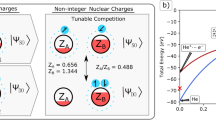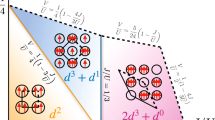Abstract
Charge density waves (CDWs) in transition-metal compounds are shown to be a consequence of the first-order character of the crossover from localized to itinerant d-electron behavior; they are formed as this crossover is approached from either the localized-electron or the itinerant-electron side. Opening of a gap at the Fermi energy by changing the periodicity of the electron potential energy is a description that is only applicable on the approach from the itinerant-electron side. At crossover, single-valent transition-metal compounds with metal–metal d-electron bonding form cation clusters in which d-electrons are confined to molecular orbitals; normally, the individual bonds of a cluster are electron-pair bonds. However, in Zn[V2]O4, orbital ordering of a localized 3d-electron in an xy-orbital lowers the V–V separation in [011] and [101] chains sufficiently that the yz ± izx orbitals approach crossover from the localized-electron side. To resolve the magnetic frustration associated with the antiferromagnetic coupling between the localized spins in neighboring xy orbitals, the yz ± izx electrons become confined to one-electron bonds in a zigzag chain rather than an electron-pair bond within a dimer. The itinerant d-electrons of the zigzag chains are spin-polarized by intra-atomic exchange with xy-orbital spins. At crossover, compounds with cation–anion–cation bonding segregate into cations of an anion complex and cations with localized-electron spins; these segregations commonly result in a disproportionation electron transfer between cations that result in a static “negative-U” CDW in either single-valent or mixed-valent systems, but the perovskite HoNiO3 demonstrates that this electron transfer does not always occur. The insertion of interstitial Oi atoms in the \( {\hbox{L}}{{\hbox{a}}_2}{\hbox{Cu}}{{\hbox{O}}_{{\rm{4}} + \delta }} \) system allows monitoring of the formation of a dynamic phase segregation into mobile multihole polarons in a hole-free matrix that order into a thermodynamically distinct superconductive phase. The polarons may either order into pinned metallic stripes or as two-hole, two-electron bosonic polarons that become pinned to phonons in a superconductive phase that masks a quantum critical point.

Similar content being viewed by others
References
Schöllhorn R (1982) Solvated intercalation compounds of layered chalcogenide and oxide bronzes. In: Whittingham MS, Jacobson AJ (eds) Intercalation chemistry. Academic, New York, pp 315–360
Goodenough JB (2002) Oxide cathodes. In: Schalkwijk WA, Scrosati B (eds) Advances in lithium-ion batteries. Kluwer Academic/Plenum, New York, pp 135–154
Goodenough JB (1984) The effective U in oxides and sulfides. In: Acrivos JV, Mott NF, Yoffe A (eds) NATO “Davy” ASI. Physics and chemistry of electrons and ions in condensed matter. Reidel, Dordrecht, pp 1–44
Anderson PW (1959) Phys Rev 115:2–13
Adler D, Brooks H (1967) Phys Rev 155:826–840
Goodenough JB (2001) Struct Bond 98:1–16
Bersuker GI, Goodenough JB (1997) Physica C 274:267–285
Morin FJ (1959) Phys Rev Lett 3:34–36
Andersson G (1956) Acta Chem Scand 10:623–630
Heckingbottom R, Linnett JW (1962) Nature 194:678
Kittel C (1996) Introduction to solid state physics, 7th edn. Wiley, New York, 300
Lomer WM (1962) Proc Phys Soc 80:489–496
Bongers PF (1957) Thesis. Univ. of Leiden, July 4
Pen HF, van den Brink J, Khomskii DI, Sawatzky GA (1997) Phys Rev Lett 78:1323–1326
Goodenough JB (1971) Prog Solid State Chem 5:145–399
Rogers DB, Arnott RJ, Wold A, Goodenough JB (1963) J Phys Chem Solids 24:347–360
Pardo V, Blanco-Canosa S, Rivadulla F, Khomskii DI, Baldomir D, Wu H, Rivas J (2008) Phys Rev Lett 101:256403-1–256403-4
Baldomir D, Pardo V, Blanco-Canosa S, Rivadulla F, Khomskii DI, Wu H, Piñeiro A, Arias JE, Rivas J (2009) J Mag Mag Mater 321:679–681
Goodenough JB (1967) Czech J Phys 17:304–336
Zhou JS, Goodenough JB (2004) Phys Rev B 69:153105-1–153105-4
Alonso JA, Martinez-Lope MJ, Casais MT, Garcia-Munoz JL, Fernandez-Diaz MT, Aranda MAC (2001) Phys Rev B 64:094102-1–094102-10
Zhou JS, Goodenough JB, Dabrowski B (2005) Phys Rev Lett 94:226602-1–226602-4
Wattiaux A, Park JC, Grenier JC, Pouchard M (1990) CR Acad Sci Ser II 310:1047–1054
Grenier JC, Lagueyte N, Wattiaux A, Doumerc JP, Dordor P, Etourneau J, Pouchard M, Goodenough JB, Zhou JS (1992) Physica C 202:209–218
Zhou JS, Chen H, Goodenough JB (1994) Phys Rev B 50:4168–4180
Grant PM, Parkin SSP, Lee VY, Engler EM, Ramirez MC, Vasquez JE, Lim G, Jacowitz RD, Greene RL (1987) Phys Rev Lett 58:2482–2485
Johnson DC DC, Stokes JP, Goshorn DP, Lewandowski JT (1987) Phys Rev B 36:4007–4010
Chaillaut C, Chenavas J, Cheong SW, Fisk Z, Marezio M, Morosin B, Schirber JE (1990) Physica C 170:87–94
Goodenough JB, Zhou JS, Chan J (1993) Phys Rev B 47:5275–5286
Takami T, Zhou JS, Cheng JG, Goodenough JB, Matsubayashi K, Uwatoko Y (2009) New J Phys 11:013057–013069
Tranquada JM, Sternlieb BJ, Axe JD, Nakamura Y, Uchida S (1995) Nature 375:561–563
Tranquada JM, Ichikawa N, Uchida S (1999) Phys Rev B 59:14712–14722
Daou R, Doiron-Leyraud N, LeBoeuf D, Li SY, Laliberté F, Cyr-Choinière O, Lo YJ, Balicas L, Yan JQ, Zhou JS, Goodenough JB, Taillefer L (2008) Nat Phys 5:31–34
Goodenough JB (2003) J Phys Condens Matter 15:R257–R326
Schmidt M, Ratcliff W II, Radaelli PG, Refson K, Harrison NM, Cheong SW (2004) Phys Rev Lett 92:056402-1–056402-4
Goodenough JB (1982) Ann Chim 7:489–504
Battle PD, Gibb TC, Nixon S (1989) J Solid State Chem 79:75–85
Author information
Authors and Affiliations
Corresponding author
Rights and permissions
About this article
Cite this article
Goodenough, J.B. Comments on charge density waves. J Solid State Electrochem 15, 285–291 (2011). https://doi.org/10.1007/s10008-010-1096-7
Received:
Revised:
Accepted:
Published:
Issue Date:
DOI: https://doi.org/10.1007/s10008-010-1096-7




